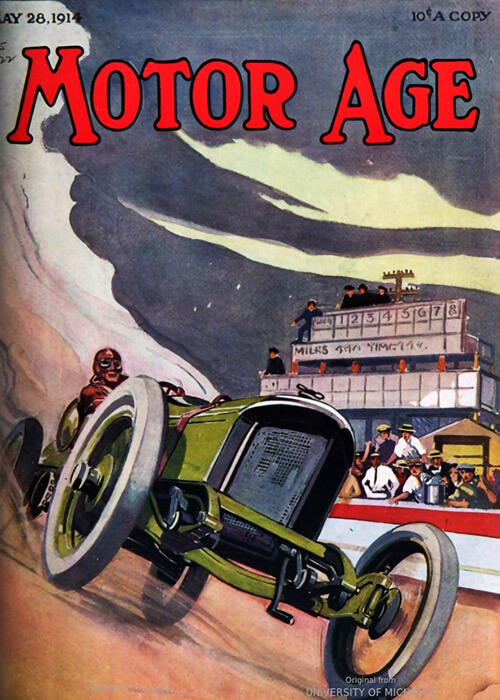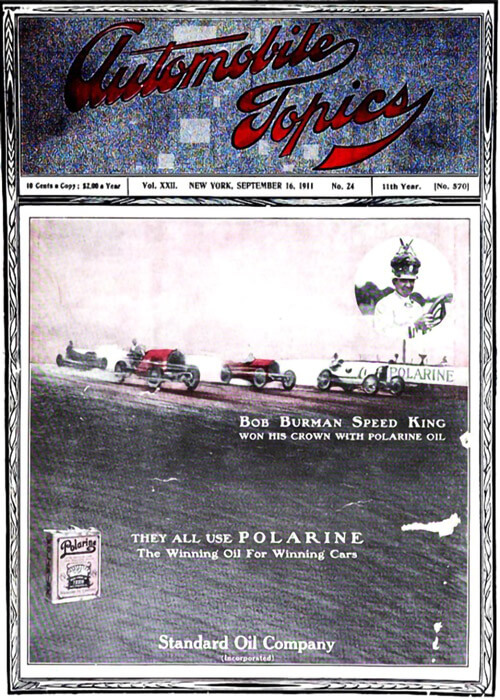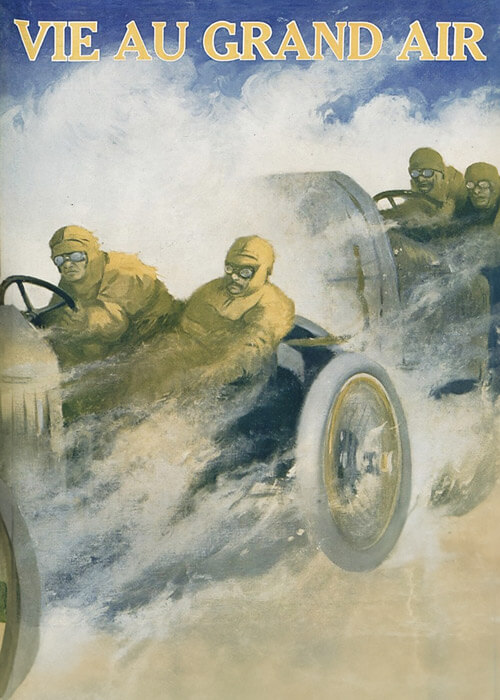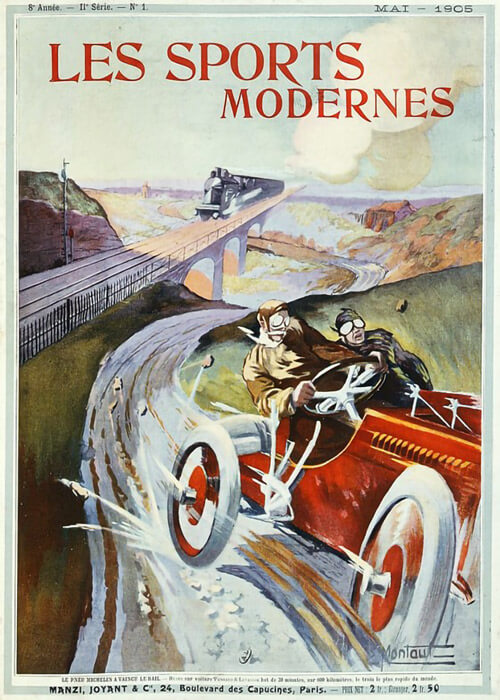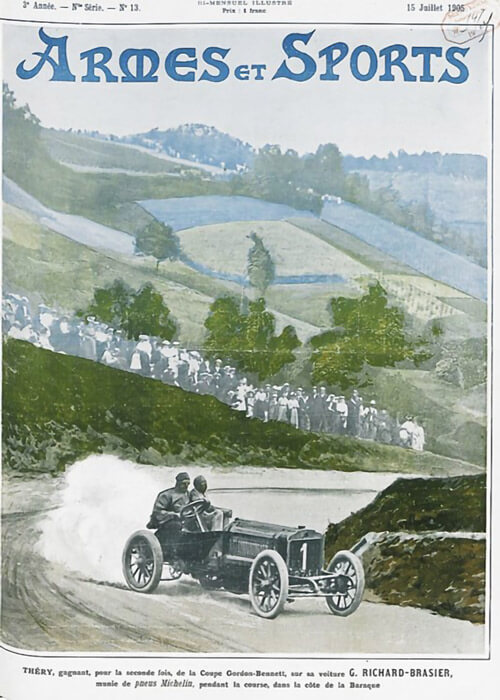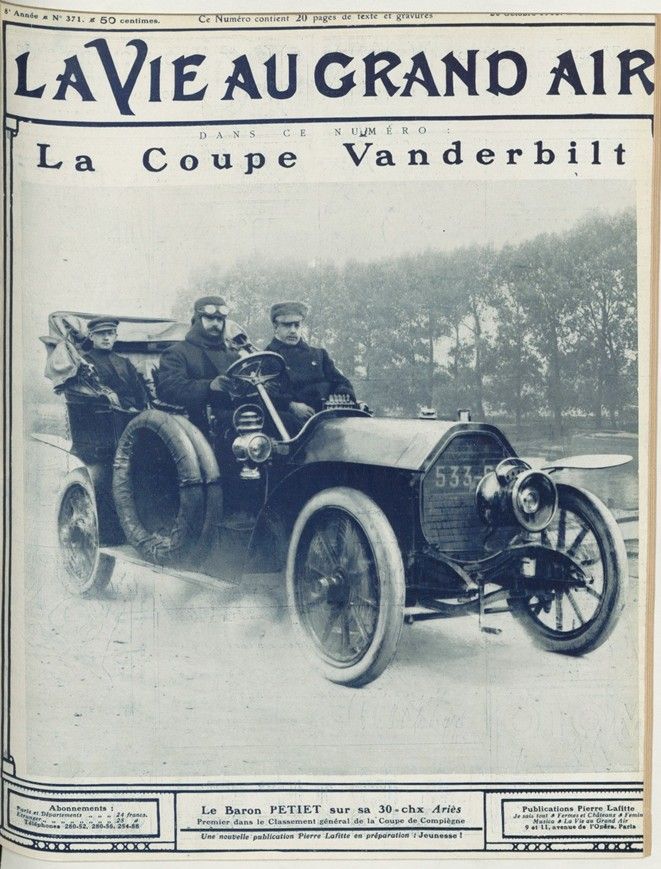
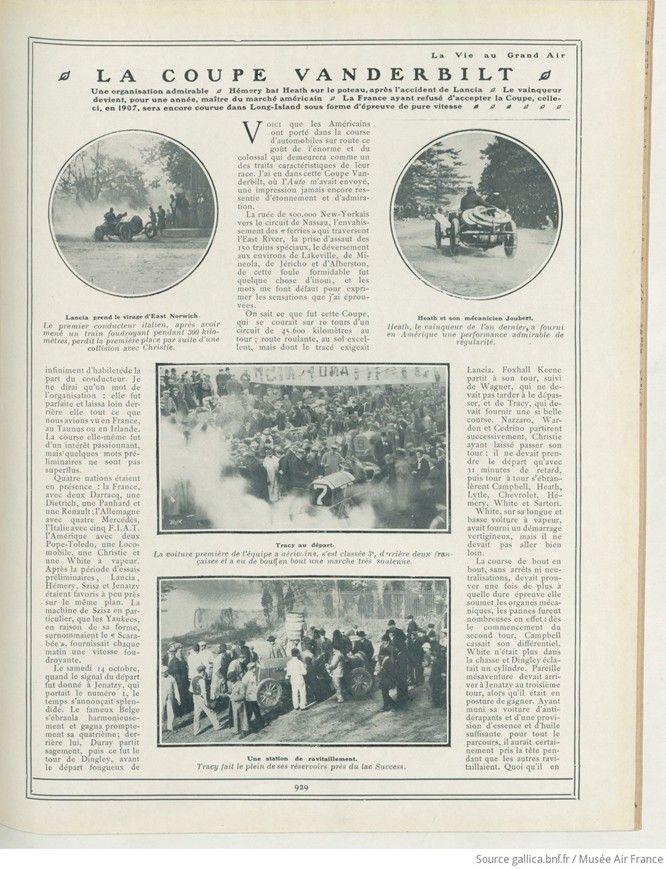

Text et images avec l’authorisation de Bibliothèque national français, gallica.bnf.fr
compilé par motorracinghistory.com,
La Vie au Grand Air, Vol. 8, No. 373, 3 novembre 1905
La Coupe Vanderbilt
Une organisation admirable * Hémery bat Heath sur le poteau, après l’accident de Lancia * Le vainqueur devient, pour une année, maître du marché américain * La France ayant refusé d’accepter la Coupe, celle-ci, en 1907, sera encore courue dans Long=Island sous forme d’épreuve de pure vitesse
Voici que les Américains ont porté dans la course d’automobiles sur route ce goût de l’énorme et du colossal qui demeurera comme un des traits caractéristiques de leur race. J’ai eu dans cette Coupe Vanderbilt, où l’Auto m’avait envoyé, une impression jamais encore ressentie d’étonnement et d’admiration.
La ruée de 500.000 New-Yorkais vers le circuit de Nassau, l’envahissement des « ferries »qui traversent l’East River, la prise d’assaut des 150 trains spéciaux, le déversement aux environs de Lakeville, de Mineola, de Jéricho et d’Alberston, de cette foule formidable fut quelque chose d’inouï, et les mots me font défaut pour exprimer les sensations que j’ai éprouvées.
On sait ce que fut cette Coupe, qui se courait sur 10 tours d’un circuit de 45.600 kilomètres au tour ; route roulante, au sol excellent, mais dont le tracé exigeait infiniment d’habileté de la part du conducteur. Je ne dirai qu’un mot de l’organisation : elle fut parfaite et laissa loin derrière elle tout ce que nous avions vu en France, au Taunus ou en Irlande. La course elle-même fut d’un intérêt passionnant, mais quelques mots préliminaires ne sont pas superflus.
Quatre nations étaient en présence : la France, avec deux Darracq, une Dietrich, une Panhard et une Renault ; l’Allemagne avec quatre Mercédès, l’Italie avec cinq F.I.A.T. l’Amérique avec deux Pope-Toledo, une Locomobile, une Christie et une White à vapeur.
Après la période d’essais préliminaires, Lancia, Hémery, Szisz et Jenatzy étaient favoris à peu près sur le même plan. La machine de Szisz en particulier, que les Yankees, en raison de sa forme, surnommaient le « Scarabée », fournissait chaque matin une vitesse foudroyante.
Le samedi 14 octobre, quand le signal du départ fut donné à Jenatzy, qui portait le numéro 1, le temps s’annonçait splendide. Le fameux Belge s’ébranla harmonieusement et gagna promptement sa quatrième ; derrière lui, Duray partit sagement, puis ce fut le tour de Dingley, avant le départ fougueux de Lancia. Foxhall Keene partit à son tour, suivi de Wagner, qui ne devait pas tarder à le dépasser, et de Tracy, qui devait fournir une si belle course. Nazzaro, Warden et Cedrino partirent successivement, Christie ayant laissé passer son tour : il ne devait prendre le départ qu’avec 31 minutes de retard, puis tour à tour s’ébranlèrent Campbell, Heath, Lytle, Chevrolet, Hémery, White et Sartori.
White, sur sa longue et basse voiture à vapeur, avait fourni un démarrage vertigineux, mais il ne devait pas aller bien loin.
La course de bout en bout, sans arrêts ni neutralisations, devait prouver une fois de plus à quelle dure épreuve elle soumet les organes mécaniques, les pannes furent nombreuses en effet : dès le commencement du second tour, Campbell cassait son différentiel, White n’était plus dans la chasse et Dingley éclatait un cylindre. Pareille mésaventure devait arriver à Jenatzy au troisième tour, alors qu’il était en posture de gagner. Ayant muni sa voiture d’anti-dérapants et d’une provision d’essence et d’huile suffisante pour tout le parcours, il aurait certainement pris la tête pendant que les autres ravitaillaient. Quoi qu’il en soit, peu après le début, la course se dessinait comme un match entre Lancia et l’équipe française. L’adroit Italien, qui avait annoncé la veille son intention de courir à tombeau ouvert, menait superbement précédant de quelques minutes Szisz, Hémery et Heath. Wagner avait éclaté devant les tribunes à 150 à l’heure et cassé peu après son changement de vitesse.
Lancia augmentait peu à peu son avance quand un coup de théâtre se produisit au cours du septième tour. Le premier conducteur italien quittait un ravitaillement de pneus au moment où Christie arrivait à 700 ou 800 mètres derrière.
Sans doute ne le vit-il pas à temps, car il traversa obliquement la route avant sa remise en vitesse et Christie le tamponna à plus de 100 à l’heure ; les avaries entraînées coûtèrent à Lancia 45 minutes d’arrêt, à Christie, son arrêt définitif et des blessures assez ; sérieuses pour nécessiter son transport à l’hôpital… il est maintenant hors de danger.
Les spectateurs des tribunes, avertis de la collision par le speaker, pensèrent alors que la France sortirait une seconde fois victorieuse. Heath était en tête et eût sans doute, avec un peu plus d’audace, renouvelé son triomphe de 1904.
Mais Hémery le suivait de près et gagnait énormément dans les virages. Il rattrapa Heath à quelques milles avant l’arrivée, le passa a la corde au tournant de Lakeville et tous deux finirent séparés par quelques centaines de mètres. Hémery étant parti 3 minutes après Heath gagnait ainsi la seconde coupe Vanderbilt, ce qui, après sa victoire à Brescia couronnait splendidement une magnifique saison de courses. Lancia dans un retour terrible manquait de moins de 2 minutes la troisième place, que lui soufflait Tracy, dont la Locomobile fournissait ainsi une excellente performance. La course fut ensuite arrêtée, afin d’éviter tout accident.
Les trois meilleurs conducteurs avaient été Lancia, Jenatzy et Hémery, mais le dernier seul devait trouver la juste récompense de ses efforts. La voiture la plus rapide fut celle de Szisz, la voiture la plus régulière fut celle de Heath.
Hémery fit sur l’ensemble une moyenne frisant les 100 à l’heure, mais Lancia avait établi un beau record en couvrant les 300 premiers kilomètres à près de 115 de moyenne.
On se ferait difficilement une idée de l’enthousiasme qu’excita la victoire d’Hémery, et pour qui connaît le pratique esprit yankee, elle aura les meilleurs effets pour sa marque. Il suffit de songer qu’il y a, dans le seul Etat de New-York, 13.000 automobiles et qu’il y a là, dans toute la région de l’Est, une clientèle extrêmement importante. C. FAROUX.
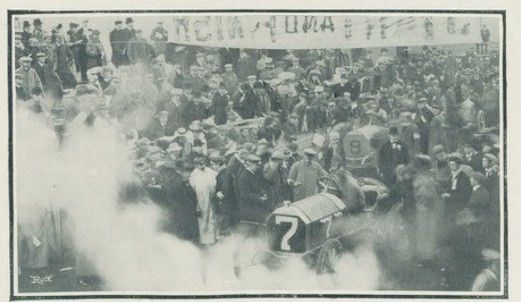
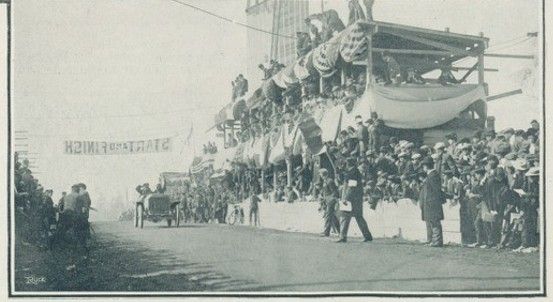
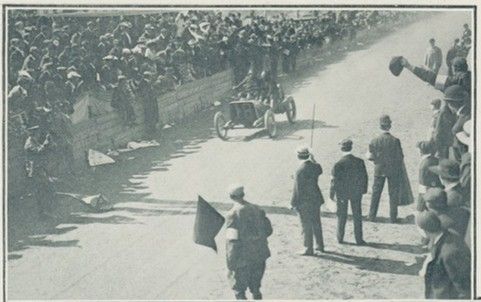
Translation by motorracinghistory, supported by DeepL.com
THE VANDERBILT CUP
An admirable organization * Hémery beats Heath on the post, after the Lancia accident * The winner becomes, for one year, master of the American market * As France refused to accept the Cup, in 1907 it will again be raced in Long Island as a pure speed event *
Now the Americans have brought this taste for the enormous and the colossal to road car racing, which will remain one of the characteristic features of their race. In this Vanderbilt Cup, which the Automobile had sent me to, I was filled with an unprecedented sense of astonishment and admiration.
The rush of 500,000 New Yorkers to the Nassau circuit, the invasion of the ferries crossing the East River, the storming of the 150 special trains, the spilling of this formidable crowd around Lakeville, Mineola, Jericho and Alberston was something unheard of, and I cannot find the words to express the feelings I experienced.
We know what this Cup was like, which was run over 10 laps of a 45,600-kilometer circuit; a fast track with excellent ground, but whose layout required infinite skill on the part of the driver. I will only say a word about the organization: it was perfect and left far behind everything we had seen in France, in the Taunus or in Ireland. The race itself was fascinating, but a few preliminary words are not superfluous.
Four nations were present: France, with two Darracqs, one Dietrich, one Panhard and one Renault; Germany with four Mercedes, Italy with five FIATs, America with two Pope-Toledo, one Locomobile, one Christie and one White steam car.
After the preliminary trials, Lancia, Hémery, Szisz and Jenatzy were the favorites, all on more or less the same level. Szisz’s car in particular, which the Yankees nicknamed the “Beetle” because of its shape, reached lightning speeds every morning.
On Saturday, October 14, when the starting signal was given to Jenatzy, who was wearing number 1, the weather looked splendid. The famous Belgian got off to a smooth start and quickly gained his fourth; behind him, Duray made a sensible start, then it was Dingley’s turn, before the spirited departure of Lancia. Foxhall Keene took his turn, followed by Wagner, who was not long in overtaking him, and Tracy, who was to put in such a fine performance. Nazzaro, Warden and Cedrino set off in succession, with Christie having let his turn go by: he was only to start 31 minutes late, then Campbell, Heath, Lytle, Chevrolet, Hémery, White and Sartori took their turns to set off.
White, in his long, low steam car, had made a dizzying start, but he was not to go far.
The race from start to finish, without stops or neutralizations, was to prove once again how hard it is on mechanical parts, and there were indeed numerous breakdowns: at the start of the second lap, Campbell broke his differential, White was no longer in the hunt and Dingley blew a cylinder. A similar mishap was to befall Jenatzy on the third lap, just as he was in a position to win. Having equipped his car with anti-skid tires and a supply of fuel and oil sufficient for the entire course, he would certainly have taken the lead while the others refueled. In any case, shortly after the start, the race took shape as a match between Lancia and the French team. The skilful Italian, who had announced the day before his intention to race flat out, was leading superbly, a few minutes ahead of Szisz, Hémery and Heath. Wagner had burst past the stands at 150 kph and shortly afterwards broken his gearshift.
Lancia gradually increased its lead when a dramatic turn of events occurred on the seventh lap. The leading Italian driver was leaving a tire refueling point just as Christie was arriving 700 or 800 meters behind.
He probably didn’t see him in time, because he crossed the road diagonally before he could get back up to speed and Christie hit him at over 100 km/h; the resulting damage cost Lancia 45 minutes of downtime, and for Christie it was the end of the race, as well as serious injuries that required him to be taken to hospital… he is now out of danger.
The spectators in the stands, alerted to the collision by the announcer, thought that France would emerge victorious for a second time. Heath was in the lead and, with a little more daring, would undoubtedly have repeated his 1904 triumph.
But Hémery was close behind and gained enormously in the bends. He caught up with Heath a few miles before the finish line, passed him on the inside at the Lakeville turn and they finished just a few hundred meters apart. Hémery having started 3 minutes after Heath thus won the second Vanderbilt Cup, which, after his victory in Brescia, was a splendid crowning achievement of a magnificent racing season. Lancia, in a tremendous comeback, missed out on third place by less than two minutes, which went to Tracy, whose Locomobile thus put in an excellent performance. The race was then stopped to avoid any accidents.
The three best drivers were Lancia, Jenatzy and Hémery, but only the latter was to find due reward for his efforts. The fastest car was Szisz’s, the most consistent was Heath’s.
Hémery’s overall average was close to 100 kilometers per hour, but Lancia had set a fine record by covering the first 300 kilometers at an average of nearly 115.
It is difficult to imagine the enthusiasm aroused by Hémery’s victory, and for those familiar with the practical Yankee spirit, it will have the best effects for his brand. One need only consider that there are 13,000 automobiles in the state of New York alone and that there is an extremely large customer base there in the entire Eastern region. C. FAROUX.
